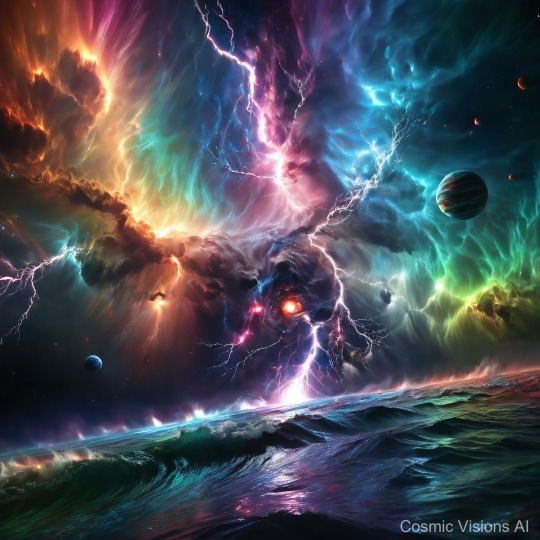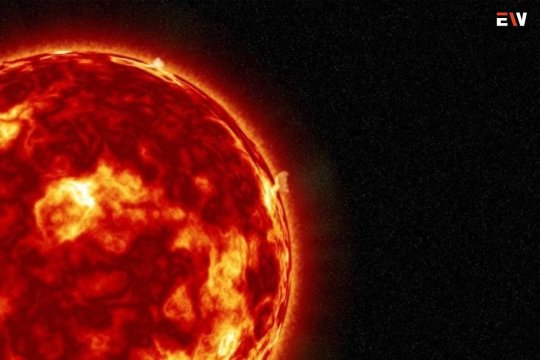#CelestialSpectacle
Explore tagged Tumblr posts
Photo





Planet Vespera, with its vivid azure atmosphere, pulsates with breathtaking electric auroras, unparalleled in our galactic surveys. These radiant displays, caused by intense magnetic fields interacting with solar winds, illuminate the planet continuously, offering a perpetual celestial ballet visible even from orbit. The spectacle hints at extreme electromagnetic activity that governs weather patterns across Vespera’s surface. The surface, viewed through breaks in the glowing skies, reveals jagged mountains and rock formations, largely barren due to the strong electrical storms that frequently riddle the terrain. The minimal vegetation that does survive clings to crevices and is adapted to the highly ionized environment. Vespera's beauty is stark, characterized by its vibrant skies and the severe, sculpted landscapes below—a planet where electricity literally breathes life into the very air.
#ElectricAuroraSkies#CosmicLightshow#AuroraPhotography#SpaceWeather#Astrophotography#NorthernLights#AuroraBorealis#CelestialSpectacle#DeepSpaceBeauty#GalacticColors
0 notes
Link
On a recent Monday, the skies above weren't just a backdrop for Delta flights 1218 and 1010. They became a stage for a truly unforgettable experience – a total solar eclipse witnessed from the unique vantage point of an airplane soaring through the path of totality. Beyond the awe-inspiring astronomical phenomenon, the flights fostered unexpected connections, heartwarming celebrations, and even a once-in-a-lifetime marriage proposal. A Front-Row Seat to Totality: Witnessing the Eclipse from Above Delta flights 1218, departing from Austin-Bergstrom International Airport (AUS), and 1010, taking off from Dallas/Fort Worth International Airport (DFW), both had Detroit Metropolitan Wayne County Airport (DTW) as their final destination. However, the journey on April 8th, 2024, held a special significance. These specifically chosen flights offered passengers a rare opportunity – a glimpse of the total solar eclipse from the comfort of their airplane seats. Celestial Spectacle A Surreal Experience: Witnessing the Darkness in the Sky Passengers like Paul Donlin, a frequent Delta flyer, expressed their amazement at the celestial spectacle. He described the surreal experience of seeing darkness descend outside the plane as it entered the path of totality. "Everything is dark, everything is black," Donlin recounted. "It looks a way that it shouldn't look. It doesn't work in your brain." Donlin, along with many other passengers, expressed his gratitude to Delta for the meticulous planning and commitment to safety that made this unique flying experience possible. Beyond the Eclipse: A Celebration of Community The excitement surrounding the eclipse transcended the astronomical event itself. The flights witnessed a sense of community and shared wonder. Gatehouse celebrations buzzed with anticipation, fostering connections between astrology enthusiasts and aviation aficionados alike. A Proposal for the Ages: A Moment of Love Under the Eclipse One passenger took the opportunity to make the experience even more extraordinary. One of the flights saw a unique, bragging-rights-level marriage proposal take place amidst the awe-inspiring backdrop of the eclipse. This heartwarming event added a touch of romance to the already unforgettable journey. The Unsung Heroes: Planning and Execution The success of these special eclipse flights wasn't a coincidence. Weeks of meticulous preparation went into ensuring a smooth and unforgettable experience for passengers. Here's a glimpse into the behind-the-scenes efforts: Pilots at the Helm: Delta pilots meticulously planned the flight paths in simulators, ensuring they would navigate through the path of totality at the precise moment. Flight Dispatchers Keeping Time: Precision was key. Flight dispatchers meticulously coordinated timing, down to the very minute, with both the flights and Air Traffic Control. This meticulous planning was crucial in ensuring that both sets of pilots could execute maneuvers that would offer passengers a breathtaking view of the eclipse. Dedicated Flight Attendants and Gate Agents: The flight attendants and gate agents played a vital role in ensuring everyone had a positive and seamless flight experience. Their commitment to passenger care and enthusiasm for the celestial event undoubtedly added to the overall success of the flights.
#Aviationenthusiasts#celestialevent#CelestialSpectacle#Deltaflights#Flightpreparation#passengerexperience#Pathoftotality#Safetymeasures.#solareclipse#Totalityexperience
0 notes
Text
0 notes
Text
0 notes
Text

🌟 Don't Miss Out! 🌟
🔭 Get ready for the celestial event of the year with the Best 10 NASA Approved Eclipse Glasses for Kids on Amazon! 🚀 Whether they're budding astronomers or just curious minds, these glasses are perfect for safe viewing of the mesmerizing eclipse.
🌞 The 2024 eclipse is approaching fast, and you don't want to be caught unprepared. These glasses are not only NASA approved but also designed with kids in mind, ensuring a comfortable and secure fit for their little faces.
✨ Say goodbye to worries about eye safety and hello to an unforgettable experience of witnessing the wonders of the universe firsthand. Plus, with Amazon's fast shipping, you'll have them in time for the big day!
🎉 So what are you waiting for? Grab your pair now and join the millions of people eagerly awaiting this spectacular event! #Eclipse2024 #NASAApproved #KidsGlasses
🛒 Shop now and make memories that will last a lifetime! 🌌 the-best-10-eclipse-glasses-nasa-approved-2024-for-kids-on-amazon 🚀
#EclipseGlasses2024#NASAForKids#SafeViewing#CelestialSpectacle#AstronomyKids#AmazonFinds#SolarEclipse#StargazingKids#NASAApproved#KidFriendlyEclipse
1 note
·
View note
Text
New Year’s Solar Spectacle: Massive Solar Flare Signals Caution Amidst Sky’s Radiant Show

A colossal solar eruption, marking the most substantial Solar flare in recent years, illuminated the skies on New Year’s Eve, signaling a cautionary alert for certain high-frequency radio users.
The NOAA’s Space Weather Prediction Center (SWPC) unveiled an image of this solar phenomenon on Sunday evening, depicting a luminous expanse on the sun, characteristic of a solar flare.
Described by the SWPC as a surge of energy from the sun that typically lasts from minutes to hours, this particular event, classified as an X5 flare, reached its peak a little before 5 p.m. ET on Sunday.
Energy Release Escalation
NASA categorizes solar flares analogous to earthquake scales, ranging from B-class to C-class, M-class, and finally, X-class. Each letter increment signifies a tenfold escalation in energy release, with the exception of X-class flares, which can surpass the value of 9. The most potent flare on record, an X45, occurred in 2003.
While B- and C-class flares remain imperceptible on Earth, M-class flares might induce transient radio disturbances at the poles and minor radiation storms hazardous to astronauts. However, X-class flares like the recent X5 can yield more conspicuous effects, such as radiation storms impacting satellites and imparting minor radiation doses to air travelers near polar regions. Moreover, they could potentially trigger global transmission disruptions and widespread blackouts.
Despite being smaller than the 2003 flare, Sunday’s X5 was the most potent since the X8.2 recorded in September 2017, surpassing the X2.8 event from December 14 in the same solar region.
Impact on Earth
The SWPC cautioned high-frequency radio users about possible signal degradation or loss due to the solar flare’s impact on the sunlit side of Earth. However, for the general populace, concerns were allayed, with the chance of witnessing auroras resulting from a detected coronal mass ejection (CME) being relatively slim.
SWPC’s forecast indicated limited states, predominantly in Alaska and Canada, having a high probability of experiencing the northern lights, while a handful of states like Washington, Idaho, and Maine held faint chances.
While a minor geomagnetic storm watch was issued for Tuesday, the likelihood of aurora sightings seemed even lower based on SWPC’s projections.
Anticipated to become more frequent in 2024, solar activities and CMEs are attributed to the sun’s progression through Solar Cycle 25, 11-year intervals characterized by magnetic pole reversals inducing space weather phenomena.
Despite potential impacts on navigation, communication, and radio signals, Dr. Delores Knipp from the University of Colorado Boulder reassured the public about existing safeguards in electrical grids and communication systems to mitigate adverse effects from solar storms. She stressed that such events, like Sunday’s solar flare, are routine and not cause for undue concern.
NASA’s Clarification
NASA clarified that catastrophic scenarios of a ‘killer solar flare‘ annihilating Earth are implausible. Additionally, with solar cycles recurring every 11 years, most individuals have already experienced a solar maximum without noticing.
A silver lining to this solar cycle is the forthcoming total solar eclipse on April 8, 2024, set to coincide near the cycle’s peak, promising an enthralling spectacle for sky gazers, as outlined by NOAA.
Curious to learn more? Explore our articles on Enterprise Wired
#SolarFlare#SpaceWeather#CelestialSpectacle#NewYearEve#NASA#Astronomy#SolarActivity#SpaceExploration
0 notes
Text
Witness the Unforgettable Dance of the Moon and Mars as They Embrace in the Sunset Glow! Don't Miss This Celestial Spectacle!

Witness the harmonious spectacle as the moon and Mars unite in the embrace of a shared sunset tonight. As the waxing crescent moon journeys towards the weekend, it draws near to the Red Planet, forging a close bond that will be on full display. On Friday, August 18, from the vantage point of New York City, this celestial companionship will unfold. The moon and Mars will grace the sky shortly after emerging above the horizon at approximately 8:35 a.m. EDT (1235 GMT), and their union will persist throughout the day and the ensuing sunset. Just before the clock strikes 9:01 p.m. EDT (0101 GMT), they will gradually dip beneath the horizon, their luminous connection lingering in the twilight. For those eager to witness this celestial choreography, the western horizon is your canvas. As the sun bids farewell for the day, seek out the moon, but ensure an unobstructed view of the horizon. Mars, a tad fainter, will nestle just below and to the left of the moon. And if you're feeling particularly adventurous, turn your gaze towards the distant Mercury, a fainter and more delicate presence compared to Mars. This innermost denizen of our solar system will position itself approximately 6 degrees below the moon, a span roughly half the width of your outstretched hand. The moon, a mere three days young in its waxing crescent phase, will cozy up to Mars at a proximity of about 1 degree, a distance smaller than the width of a finger seen from arm's length. Amidst this close encounter, both moon and Mars will find themselves within the embrace of the Pisces constellation. The moon will radiate with a brilliance of -9.5 (a minus sign indicating its luminosity surpassing Earth's), while Mars will exhibit a subtler glow at a magnitude of 1.8. Meanwhile, Mercury, if discernible, will outshine Mars slightly with a magnitude of 0.6. Separated by a distance of 29 degrees from the setting sun within the Leo constellation, the pairing of moon and Mars will tantalize observers. Despite their apparent closeness, their spatial relationship remains distant enough to evade simultaneous capture in a telescope's eyepiece. However, with binoculars, the spectacle should grace your field of vision. Simultaneously, as this close approach occurs, the two celestial bodies will align in an event astronomers term a conjunction—a celestial version of longitude, where they share the same right ascension in the sky. The nearness of Mars and the moon on this Friday is a consequence of our Earth-bound perspective of the solar system. While the average Earth-moon distance hovers around 238,855 miles (384,400 kilometers), the gap separating us from Mars, the fourth planet from the sun, stretches to around 140 million miles (225 million kilometers) on average. Presently, Mars extends about 226 million miles (365 million kilometers) away, according to The Sky Live. Come mid-October 2023, Mars will reach its utmost distance from Earth, spanning approximately 240 million miles (381 million kilometers). However, the Red Planet will draw intimately close to Earth and the moon by mid-January 2025, when they will stand separated by roughly 60 million miles (96 million kilometers). For those eager to partake in this celestial rendezvous, our guide to premier binoculars offers a promising starting point. Likewise, if your curiosity urges you to gaze even deeper, our guide to superior telescopes can guide you towards the optimal optical equipment. Should capturing this celestial dance through photography capture your imagination, our guide on photographing the moon and our recommendations for astrophotography cameras and lenses await your perusal. Editor's Note: If you manage to capture a snapshot of the moon and Mars's close encounter and wish to share it with the readers of Space.com, kindly send your photos, insights, along with your name and location, to [email protected]. Read the full article
0 notes
Link
0 notes
Photo

Damn clouds move out of the way...🌒😎😳#eclipselook . . #tryinghard #painedlook #solareclipse #catchaglimpse #greatphenomenon #celestialspectacle #howcooldoilook #flamminghot #lifetimexperience #fun #superexcited #style #sunglasses #fashionaccessory #fashion #glow #lifeofexperiences #aneetlife @neetlife #totaleclipse #onceinalifetime #summertime (at River North Neighborhood)
#eclipselook#catchaglimpse#fashionaccessory#glow#lifetimexperience#aneetlife#style#fashion#onceinalifetime#flamminghot#summertime#fun#painedlook#greatphenomenon#solareclipse#tryinghard#sunglasses#totaleclipse#howcooldoilook#celestialspectacle#superexcited#lifeofexperiences
0 notes
Text
Excitement is brewing across America for the upcoming total solar eclipse on April 8, 2024. This rare event will sweep across Mexico, the United States, and Canada, casting a mesmerizing shadow on the land. But here's the catch: not everyone in the US will get the full show.
0 notes